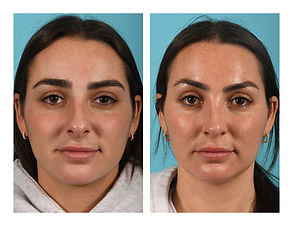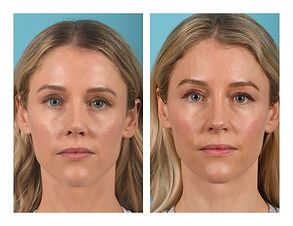Revision Rhinoplasty
A significant portion of Dr. Toriumi's practice is devoted to revision rhinoplasty (correcting problems from a previous rhinoplasty). Revision rhinoplasty is needed when a primary rhinoplasty does not adequately resolve cosmetic or functional issues, or when specific imbalances arise post-surgery or worsen. If the nose, for example, is not in balance with other facial features due to problems from previous surgery or unanticipated issues associated with poor healing, revision rhinoplasty may be indicated. With the typical reductive rhinoplasty techniques, is not unusual for the patient to have an improvement in the appearance of their nose early postoperative and then deform over time. Dr. Toriumi's structure techniques are designed to provide a good long-term outcome. The patient must understand that their nose will look swollen and possibly wider early on, only to improve with time.
For these reasons, revision rhinoplasty can be more complex than a first surgery. That is why a surgeon specialized in revision/correction is critical. Successful revision rhinoplasty surgeons typically have – and should have – experience with more complex issues around structure and function that may have been compromised or incompletely addressed by primary surgery. For you the patient, your personal treatment, appearance, and structural/functional goals are even more critical to address and fulfill via revision rhinoplasty, for obvious reasons.
To this end, Dr. Toriumi’s experience and expertise with revision rhinoplasty are unmatched – as he performs more than 200 such procedures each year. He believes that every detail of revision rhinoplasty is more complex than with primary rhinoplasty, and is magnified by the hesitancy many patients express around additional surgery. The revision rhinoplasty surgeon, then, should be committed to an even higher level of sensitivity to the patient’s concerns and commitment to the patient’s needs, wishes, and desired results.
Over his 30+ years of practice, he has mastered and refined – and continues to refine – his technique. This has included replacing ear cartilage used in secondary cases with rib (costal) cartilage, for example. This critical adaptation of technique – detailed in many of Dr. Toriumi’s peer-reviewed papers and other writings – reflected his recognition that the use of ear cartilage, a less complex procedure, sometimes did not produced the long-term results patients demand, with some instances of ear cartilage being pinched, leading to somewhat compromised nasal function.
Rib cartilage, on the other hand, is high-quality and strong, producing resilient and durable grafting material. Dr. Toriumi adapted and refined a revolutionary technique that allows for very thin costal cartilage grafts that are strong to support long-term function – a technique that requires a smaller initial incision that, combined with reduced dissection, minimizes recovery discomfort and time.
For a majority of revision rhinoplasty patients, Dr. Toriumi must construct a new supporting nasal structure to provide a proper shape. These major reconstructions are extremely difficult and necessitate an accurate understanding of three-dimensional nasal contours.
When a patient undergoes a revision rhinoplasty procedure, scar tissue can develop that can complicate subsequent reconstructions. Dr. Toriumi understands that there is a large degree of variability in revision rhinoplasty deformities. Some patients have problems that are difficult to correct. For this reason, some noses can be effectively corrected while others have a higher risk of problems or persistent deformity that may require an additional surgery (revision).
Dr. Toriumi emphasizes preservation with minimal excision.
Dr. Toriumi’s techniques enhance the preservation of your nasal structures while limiting the need for excision of supporting tissues. He avoids removing too much of the supporting structures because it can result in a pinched, upturned tip with nasal obstruction – an “operated look”. The use of cartilage grafts -- from the ear or the rib -- is undertaken to increase the strength of the nose. This minimizes undesirable changes that could otherwise occur.
Dr. Toriumi maximizes your nasal function.
Dr. Toriumi believes compromising your nasal function for a better-looking nose is unnecessary. Your nasal function is vital, and he considers it as important as your aesthetic outcome. Without both, no surgery can be considered successful. He will ensure that, after your surgery, you will breathe better and have improved nasal function over the long term. Even if you do not complain of nasal obstruction, Dr. Toriumi will maximize your nasal airway to avoid nasal obstruction as you age.
For these reasons, secondary rhinoplasty can be more complex than a first surgery. That is why a surgeon specialized in revision/correction is critical. Successful secondary rhinoplasty surgeons typically have – and should have – experience with more complex issues around structure and function that may have been compromised or incompletely addressed by primary surgery. For you the patient, your personal treatment, appearance, and structural/functional goals are even more critical to address and fulfill via secondary rhinoplasty, for obvious reasons.
To this end, Dr. Toriumi’s experience and expertise with secondary rhinoplasty are unmatched – as he performs more than 200 such procedures each year. He believes that every detail of secondary rhinoplasty is more complex than with primary rhinoplasty, and is magnified by the hesitancy many patients express around additional surgery. The revision rhinoplasty surgeon, then, should be committed to an even higher level of sensitivity to the patient’s concerns and commitment to the patient’s needs, wishes, and desired results.
Over his 30+ years of practice, he has mastered and refined – and continues to refine – his technique. This has included replacing ear cartilage used in secondary cases with rib (costal) cartilage, for example. This critical adaptation of technique – detailed in many of Dr. Toriumi’s peer-reviewed papers and other writings – reflected his recognition that the use of ear cartilage, a less complex procedure, sometimes did not produced the long-term results patients demand, with some instances of ear cartilage being pinched, leading to somewhat compromised nasal function.
Rib cartilage, on the other hand, is high-quality and strong, producing resilient and durable grafting material. Dr. Toriumi adapted and refined a revolutionary technique that allows for very thin costal cartilage grafts that are strong to support long-term function – a technique that requires a smaller initial incision that, combined with reduced dissection, minimizes recovery discomfort and time.
For a majority of secondary rhinoplasty patients, Dr. Toriumi must construct a new supporting nasal structure to provide a proper shape. These major reconstructions are extremely difficult and necessitate an accurate understanding of three-dimensional nasal contours.
When a patient undergoes a secondary rhinoplasty procedure, scar tissue can develop that can complicate subsequent reconstructions. Dr. Toriumi understands that there is a large degree of variability in secondary rhinoplasty deformities. Some patients have problems that are difficult to correct. For this reason, some noses can be effectively corrected while others have a higher risk of problems or persistent deformity that may require an additional surgery (revision).
Dr. Toriumi emphasizes preservation with minimal excision.
Dr. Toriumi’s techniques enhance the preservation of your nasal structures while limiting the need for excision of supporting tissues. He avoids removing too much of the supporting structures because it can result in a pinched, upturned tip with nasal obstruction – an “operated look”. The use of cartilage grafts -- from the ear or the rib -- is undertaken to increase the strength of the nose. This minimizes undesirable changes that could otherwise occur.
Dr. Toriumi maximizes your nasal function.
Dr. Toriumi believes compromising your nasal function for a better-looking nose is unnecessary. Your nasal function is vital, and he considers it as important as your aesthetic outcome. Without both, no surgery can be considered successful. He will ensure that, after your surgery, you will breathe better and have improved nasal function over the long term. Even if you do not complain of nasal obstruction, Dr. Toriumi will maximize your nasal airway to avoid nasal obstruction as you age.


























































